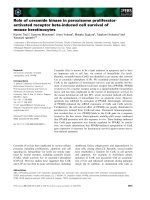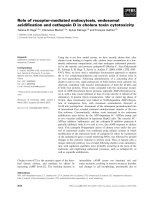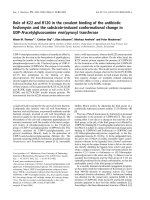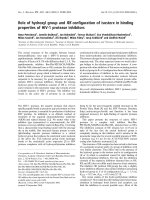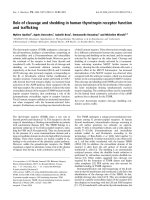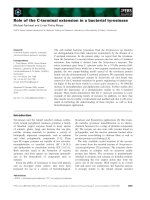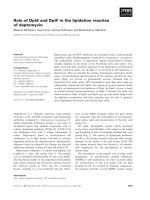Báo cáo khoa học: Role of phosphorylation in p53 acetylation and PAb421 epitope recognition in baculoviral and mammalian expressed proteins pdf
Bạn đang xem bản rút gọn của tài liệu. Xem và tải ngay bản đầy đủ của tài liệu tại đây (182.07 KB, 7 trang )
Role of phosphorylation in p53 acetylation and PAb421
epitope recognition in baculoviral and mammalian
expressed proteins
Lorna J. Warnock, Sally A. Raines, Trevor R. Mee and Jo Milner
YCR p53 Research Group, Department of Biology, University of York, York, UK
In response to genotoxic stress, the p53 tumour sup-
pressor protein is transiently stabilized, accumulates in
the nucleus and acts as a transcription factor [1,2]. Sta-
bilization of p53 occurs concomitantly with post-trans-
lational modifications, which activate p53 for DNA
repair, apoptosis and ⁄ or cell cycle arrest at G
1
⁄ Sor
G
2
⁄ M [3,4]. p53 is post-translationally modified by
phosphorylation, acetylation, ubiquitination, sumoyla-
tion and neddylation [5–7]. Of these modifications,
phosphorylation and acetylation have been studied in
greatest detail [8]. Phosphorylation occurs at multiple
sites within the N and C termini of p53 [9–11]. Acety-
lation of p53 can occur at C-terminal lysines K320,
K370-373, K381 and K382, but K373 and K382
appear to be the major sites for acetylation [12,13].
More recently, lysine 305 has also been identified as a
novel p300-mediated p53 acetylation site [14].
In this work we generated a series of p53 ‘phos-
phorylation’ mutants and constructed vectors for their
expression either in insect cells, using baculoviral
expression vectors (BVEs), or in a mammalian in vitro
transcription ⁄ translation reticulocyte lysate system.
Using antibodies specific for the modified residues of
p53 we explored the influence of specific phosphoryla-
tion mutants upon the actual phosphorylation of p53
at S15 and upon the acetylation of p53 at K373 and
at K382.
Results and Discussion
His-tagged recombinant p53 proteins were expressed in
Sf9 insect cells by using the baculoviral system and
were purified as described previously [15]. Both human
and murine p53 proteins were studied and included a
Keywords
acetylation; p53 protein; PAb421 epitope;
phosphorylation
Correspondence
L. J. Warnock, YCR p53 Research Group,
Department of Biology, University of York,
York, YO10 5 DD, UK
Fax: +44 1904 328622
Tel: +44 1904 328624
E-mail:
(Received 1 December 2004, revised 24
January 2005, accepted 31 January 2005)
doi:10.1111/j.1742-4658.2005.04589.x
Post-translational modifications, such as phosphorylation and acetylation
of the tumour suppressor protein p53, elicit important effects on the func-
tion and the stability of the resultant protein. However, as phosphorylation
and acetylation are dynamic events subject to complex controls, elucidating
the relationships between phosphorylation and acetylation is difficult. In
the present study we sought to address this problem by comparing full-
length wild-type p53 with full-length p53 proteins mutated at specific phos-
phorylation targets. Recombinant murine p53 proteins were expressed in
insect cells (using the baculoviral expression vector system) and in a mam-
malian in vitro transcription ⁄ translation reticulocyte lysate system. In p53
proteins derived from baculoviral expression vectors, S37A (but not S37D)
was found to abrogate phosphorylation at S15. Lysine 382 (K382) is con-
stitutively acetylated and was shown to form part of the epitope recognized
by PAb421. Lysine 373 (K373) was only acetylated following substitutions
at S315 (S315A or S315D) or at S378 (S378A). Importantly, in baculoviral
expressed proteins, PAb421 reactivity was independent of K373 acetylation
status, indicating that acetylation at K382 specifically determines the
PAb421 epitope.
Abbreviations
BVE, baculoviral vector expression system.
FEBS Journal 272 (2005) 1669–1675 ª 2005 FEBS 1669
dimeric mutant of murine p53 (M340Q ⁄ L344R), which
can form dimers but not tetramers [16]. We have previ-
ously characterized the quality of p53 protein obtained
under the culture conditions employed here and dem-
onstrated (a) wild-type conformational structure (react-
ive with the mAb PAb1620) and (b) the formation of
tetramers for intact p53 and also the formation of
dimers for the dimeric mutant. There was little, if any,
aggregation of the purified p53 protein (A. Okorokov
& J. Milner, Dept Biology, University of York, unpub-
lished data). Equivalent aliquots of p53 protein were
resolved by SDS ⁄ PAGE and immunoblotted with site-
specific monoclonal antibodies (mAbs), using PAb240
as reference control for total p53 (Fig. 1; note that
PAb240 and anti-His-tag Ig gave equivalent results for
p53 protein; data not shown).
Serine 15 is constitutively phosphorylated
and lysine 382 is constitutively acetylated
First, we ascertained the constitutive status of p53
modifications at serine 15 (S15) and at lysine 373
(K373) and lysine 382 (K382) for recombinant p53
expressed in insect cells. The results clearly show that
S15 is constitutively phosphorylated on wild-type p53,
both human and murine, and also on a dimeric mutant
of murine p53 (M340Q ⁄ L344R, Fig. 1). In the case of
acetylation we observed site-specific differences at
K373 and K382. Thus there was little, if any, acetyla-
tion at K373 (K373Ac), whereas K382 appeared to be
constitutively acetylated. These findings are consistent
with other publications which have reported that phos-
phorylation at serine 15, a modification that occurs in
response to genotoxic stress, enhances the binding of
p53 to p300 ⁄ CBP and increases the level of acetylation
at lysines 320 and 382 [10,17,18].
Note that, although the anti-K373Ac ⁄ K382Ac Ig
detects both K373Ac and K382Ac, we interpreted a
positive signal to be specific for K382Ac when K373
was shown to be nonacetylated by the site-specific
anti-K373Ac serum (as in Fig. 2). From these results
we conclude that both human and murine wild-type
p53 are constitutively phosphorylated at S15 and
acetylated at K382, but not at K373.
Next, we tested a series of murine p53 phosphoryla-
tion mutants, expressed in the baculoviral system, for
any effects on the constitutive pattern of p53 modifica-
tions at S15 and at K373 and K382. The results are
shown in Fig. 2 and summarized in Table 1. Several
points of interest emerge and are discussed below.
S37A abrogates p53 phosphorylation at S15
It is apparent that the substitution of alanine at S37
completely abrogates the constitutive phosphorylation
at S15 (Fig. 2, S37A, row 2, lane 5). In contrast, S37D
has no effect on S15 phosphorylation (Fig. 2, S37D,
PAb240
S15 P
K373Ac
K373/K382Ac
Mouse WT
Dimer
Human WT
Fig. 1. Recombinant human and murine wild-type p53 proteins are
phosphorylated at S15 and acetylated at K382 when expressed in
insect cells. Western blot analyses of purified p53 proteins are
shown, using PAb240 as reference control for total p53 protein.
Phosphorylation at S15 was detected by using phospho-p53 (S15)
antibody (New England Biolabs). Acetylated K373 was detected by
anti-(acetyl p53 lysine 373) Ig (Abcam). Acetylated K373 and ⁄ or
K382 were detected by anti-(acetyl-p53 lysine 373 ⁄ 382) Ig (Up-
state). Peroxidase chemiluminescence blotting was performed in
accordance with the manufacturer’s instructions (Roche Diagnos-
tics).
S15P
WT
Dimer
S15A
S15D
S37A
S37D
S315A
S315D
S376A
S376D
S378A
S378D
S376D/S378D
1 234 5678910 111213
PAb240
K373Ac
K373/K382Ac
Fig. 2. Phosphorylation status at S15 and acetylation status at
K373 and K382 of murine wild-type p53 and p53 proteins mutated
at specific phosphorylation sites expressed in insect cells by using
PAb240 as a reference control for total p53 protein. Western blot
analyses of murine full-length p53 proteins. Lane 1, murine wild-
type p53; lane 2, dimer mutant protein (M340Q ⁄ L344R); lanes
3–13, phosphorylation mutant proteins, as indicated.
p53 phosphorylation, acetylation and PAb421 epitope L. J. Warnock et al.
1670 FEBS Journal 272 (2005) 1669–1675 ª 2005 FEBS
row 2, lane 6). Other workers have reported that the
removal of S15 abrogates phosphorylation at S9, T18
and S20 [19]. These findings are consistent with the
theory of S15 cluster phosphorylation site interdepend-
ency. Given the well-established importance of
p53 S15P in the cellular response to DNA damage, the
discovery that S37 modification may be regulatory for
S15 phosphorylation in baculoviral-expressed proteins
remains highly significant.
As expected, S15A was nonreactive with anti-(phos-
phoserine 15) Ig (Fig. 2, row 2, lane 3), marking a loss
of ability to phosphorylate the substituted alanine at
this site. In contrast, S15D was still detected by anti-
(phosphoserine 15) Ig (Fig. 2, row 2, lane 4), confirm-
ing that the aspartic acid substitution mimics the
phosphorylation ‘status’ of the epitope. None of the
mutations at S15 and S37 (S15A, S15D, S37A or
S37D) affected the acetylation profile of p53 protein at
K373 (Fig. 2, row 3, lanes 3–6) or at K382 (Fig. 2,
bottom row, lanes 3–6). These results are supported by
other workers who found that following the deletion
of p53 N-terminal residues 13–52, proteins expressed
in MEFs remained acetylated at K382 [20] [Fig. 2,
note that phospho-p53 (S15) antibody (New England
Biolabs) and p-p53 (Ser 15)-R antibody (Santa Cruz
Biotechnology, Inc.) gave equivalent results for p53
protein. Results shown are those achieved with the
former antibody.]
Substitution at S315 induces p53 acetylation at K373
S315 is juxtaposed to the major nuclear localization sig-
nal of p53 and its phosphorylation involves S and G
2
⁄ M
cyclin-dependent kinases [21]. Our results now indicate
that in protein derived from BVEs, an intact serine resi-
due at this site has important ‘long-range’ effects on p53
post-translation modification as both alanine and aspar-
tic acid substitutions at S315 result in the acetylation of
K373 (Fig. 2, row 3, lanes 7 and 8). It was not possible
to determine formally whether K382 was acetylated
or de-acetylated under these conditions because anti-
K382Ac Ig also detects K373Ac (see above).
Modifications at S376 and S378 differentially
affect p53 acetylation
For proteins expressed in BVEs, our results indicate
that serines 376 and 378 also impact upon acetylation
at K373 and K382. Substitution of either alanine or
aspartic acid at S376 resulted in the loss of acetylation
at K382 (Fig. 2, S376A and S376D, bottom row, lanes
9 and 10). This site is normally constitutively acetylat-
ed under these experimental conditions (Fig. 1) and we
conclude that S376 may be structurally important for
acetylation to occur at K382 in the native p53 protein.
A different picture of p53 acetylation is evident for
phosphorylation mutants at S378. Here, the aspartic
acid substitution, S378D, abolishes constitutive acety-
lation at K382 without effect on K373 status (Fig. 2,
bottom row, lane 12). Results from the dual-phos-
phorylation mutant protein, S376D ⁄ S378D, further
support this data (Fig. 2, bottom row, lane 13). This
finding is important as it has recently been shown that
acetylation at K382 is responsible for p53-induced p21
activation and cell growth arrest in G
1
[20]. The alan-
ine substitution, S378A, however, resulted in a positive
signal for K373Ac (Fig. 2, bottom row, lane 11). Thus,
the results obtained for S378A are similar to those
obtained for S315A ⁄ D (see above). S378A appears to
facilitate the selective acetylation of K373 in p53.
K382Ac is part of the PAb421 epitope
Phosphorylation and acetylation cascades have many
aspects in common and are linked in the regulation
and function of p53 [4,5,22]. The interplay between
phosphorylation and acetylation of p53 at residues
K373 to K382 is very interesting. These same residues
encompass the epitope for the mAb PAb421, once
believed to activate p53 [23,24]. We were curious
to determine whether any of the C-terminal p53 modi-
fications, described above, affect epitope recognition
Table 1. Summary of p53 S15 phosphorylation status, K373 and
K382 acetylation status, and immunoreactivity with PAb421 and
PAb122 for the full-length p53 variants derived from the baculoviral
expression vector system (BEV) system used in this study.
PAb240 S15P K373Ac
K373 ⁄
K382Ac PAb421 PAb122
Hwt +++ +++
Mwt ++- +++
Dimer + + - + + +
S15A + - - + + +
S15D + + - + + +
S37A + -
a
-+++
S37D + + - + + +
S315A + + + + + +
S315D + + + + + +
S376A + + - - - -
S376D + + - - - -
S378A + + + + +
a
+
S378D + + - - - -
S376D ⁄ S378D + + - - - -
a
Note that, in contrast to the BVE system, S37A protein derived
from the mammalian in vitro transcription ⁄ translation reticulocyte
lysate was immunoreactive with phospho-p53 (S15) antibody, and
mammalian expressed S378A protein was not immunoreactive with
PAb421.
L. J. Warnock et al. p53 phosphorylation, acetylation and PAb421 epitope
FEBS Journal 272 (2005) 1669–1675 ª 2005 FEBS 1671
by PAb421. A set of clear-cut results for baculoviral
proteins emerged. All p53 mutants that lacked acetyla-
tion at K382 (namely S376A, S376D, S378D and the
double mutant, S376D ⁄ S378D; Fig. 2) also failed to
react with PAb421 (Fig. 3A, row 2 and Table 1). The
same was true for reactivity with PAb122, an anti-p53
mAb which detects an epitope similar, but not identi-
cal to, PAb421 (Fig. 3A, row 3 and Table 1). Thus, we
conclude that for proteins expressed in the baculoviral
system, acetylation at K382 is required for reactivity
with the PAb421 epitope. Our present observations
allow further refinement of the PAb421 epitope to
include K382Ac. Acetylation at K382 is site-specific
for PAb421 reactivity, as reactivity was unaffected by
the acetylation status of K373 (see Table 1). Our
results also indicate that acetylation of K382 coupled
with PAb421 reactivity are subject to modifications at
the neighbouring serine residues, S376 and S378, which
may thus play important (albeit indirect) roles in regu-
lating p53 functions [25,26].
The observation that acetylation at K382 (K382Ac)
forms part of the epitope for PAb421 is new and
important. In order to verify this hypothesis we expan-
ded our study to include bacterially expressed p53
proteins because, in the bacterial system, post-transla-
tional modifications (including phosphorylation and
acetylation) are deficient.
Recombinant murine wild-type p53 protein was
expressed in Escherichia coli BL21 cells (see the Experi-
mental procedures). Equivalent aliquots of p53 protein
were resolved by SDS ⁄ PAGE and immunoblotted with
site-specific mAbs, using PAb240 as reference control
for total p53 (Fig. 3B).
We determined the status of modifications at S15,
following p53 expression in E. coli, by using phospho-
p53 (S15) antibody (New England Biolabs) or p-p53
(Ser 15)-R antibody (Santa Cruz Biotechnology, Inc.).
As expected, we were unable to detect phosphorylation
at S15 with either antibody. In addition, murine wild-
type p53 protein expressed in E. coli was nonreactive
with PAb421 (Fig. 3b). This observation supports our
conclusion that acetylation at K382 is necessary in for-
mation of the PAb421 epitope (see above).
In previous studies, human wild-type p53 protein
expressed in E. coli was shown to be reactive with
PAb421 [4]. A possible explanation for variable PAb421
reactivity is the fact that availability of the PAb421 epi-
tope is affected by phosphorylation [25] and acetylation
(see above). Wild-type murine p53 protein, when
expressed in E. coli BL21 in this study, was found to
exhibit little, if any, PAb421 reactivity relative to
PAb240 (Fig. 3B). However, it is effective for DNA
binding with some PAb421 reactivity, as revealed by gel
shifts (data not shown).
Our data from the BVE system led us subsequently
to ascertain the constitutive status of p53 modifications
at S15 and at K373 and K382 for recombinant p53
expressed in a mammalian in vitro transcription ⁄ trans-
lation reticulocyte lysate system.
p53 proteins are expressed in the wild-type
conformation and S15 is constitutively
phosphorylated
Equivalent aliquots of p53 protein derived from the
mammalian in vitro transcription ⁄ translation reticulo-
cyte lysate system were immunoprecipitated with site-
specific mAbs and resolved by SDS ⁄ PAGE. The p53
proteins tested were found to have wild-type confor-
mation (Fig. 4, lanes 2–5) and are constitutively phos-
phorylated at S15 (Fig. 4, lane 8).
In contrast to the BVE system, our results showed
that substitution of an alanine at S37 did not abrogate
WT
Dimer
S15A
S15D
S37A
S37D
S315A
S315D
S376A
S37
6D
S378A
S37
8D
PAb240
PAb122
S376D/S378D
PAb421
S15P
BVE WT
PAb240
PAb421
E.
Coli
WT
A
B
Fig. 3. Monoclonal antibodies PAb421 and PAb122 are nonreactive
with the baculoviral vector expression system (BEV)-expressed
murine p53 phosphorylation mutant proteins, which are deacety-
lated at lysine 382. (A) Immunoreactivity of p53 proteins with
PAb421 and PAb122. Lane 1, murine wild-type p53; lane 2, dimer
mutant protein (M340Q ⁄ L344R); lanes 3–13, phosphorylation
mutant proteins, as indicated. PAb240 was used as a reference
control for total p53 protein. (B) Comparison of the immunoreactivi-
ty of purified murine wild-type p53 proteins with phospho-p53 (S15)
antibody and PAb421 expressed in BVE or E. coli BL21-competent
cells. Western blot analysis of p53 protein using PAb240 as a refer-
ence control for total p53 protein.
p53 phosphorylation, acetylation and PAb421 epitope L. J. Warnock et al.
1672 FEBS Journal 272 (2005) 1669–1675 ª 2005 FEBS
the constitutive phosphorylation at S15 (Fig. 4, row 2,
lane 8). Thus, we conclude that for specific site recog-
nition, kinases responsible for phosphorylation of S15
in insect cells are more stringent in their requirement
for phosphorylation at S37.
C-terminal p53 modifications inhibit PAb421
epitope recognition
Wild-type, S37A and S37D proteins derived from the
mammalian in vitro transcription ⁄ translation reticulo-
cyte lysate system were reactive with PAb421. How-
ever, C-terminal p53 modifications inhibited epitope
recognition by PAb421 (Fig. 4, lane 6). This is consis-
tent with studies in a mammalian system which repor-
ted that C-terminal phosphorylation by protein kinase
C abolishes recognition of the PAb421 epitope [25].
We conclude that the bacterial, mammalian and BVE
protein expression systems may differ in their post-
translational modifications, leading to differences in
availability of the PAb421 epitope. Overall, our results
are consistent with the view that phosphorylation and
acetylation occur in concert, the dynamics of which are
dependent upon the environment in which proteins are
expressed and post-translationally modified [8].
Experimental procedures
Baculoviral expression and purification
of p53 proteins
Phosphorylation mutant p53 proteins were generated by
site-directed mutagenesis [27]. Using murine p53 cDNA as
a template, mutation constructs of recombinant baculovirus
encoding His-tagged p53 derivatives were produced as pre-
viously described [28]. The human numbering of residues
for p53 was used throughout this study. Target genes were
subcloned into the vector pVL 1393 (Pharmingen, San
Diego, CA, USA) for expression in the baculoviral system
and were then integrated into the baculoviral genome by
using the BaculoGold
TM
System (PharMingen). The resul-
tant recombinant His-tagged proteins were expressed and
purified to homogeneity, as previously described [15]. Pro-
tein concentration was quantified by using the Bradford
Assay (BioRad, Hercules, CA, USA).
Western blot analysis
Western blot analysis was performed as described previ-
ously [29]. PAb240 from hybridoma cell lines detected the
presence of the epitope comprising amino acids 212–217 of
the p53 protein and represents the amount of p53 protein
loaded in each lane [30]. Phosphorylation at S15 was detec-
ted by using phospho-p53 (S15) antibody (New England
Biolabs, Beverley, MA, USA) or p-p53 (Ser 15)-R antibody
(Santa Cruz Biotechnology, Inc., Santa Cruz, CA, USA),
both of which yielded equivalent results. Acetylated K373
was detected by anti-acetyl p53 lysine 373 (Abcam,
Cambridge, MA, USA). Acetylated K373 and ⁄ or K382
were detected by anti-acetyl-p53 lysine 373 ⁄ 382 (Upstate
Charlottesville, VA, USA). PAb421 and PAb122 from
hybridoma cell lines detected the presence of the epitopes
comprising amino acids 371–382 and amino acids 370–378
of the p53 protein, respectively [31]. Peroxidase chemilumi-
nescence blotting was performed in accordance with the
manufacturer’s instructions (Roche, Mannheim, Germany).
Expression and purification of murine wild-type
p53 protein in E. coli
Using murine wild-type p53 cDNA as a template, con-
structs encoding a His-tagged p53 derivative were cloned
into the vector pcDNA3, and plasmids were transformed
into E. coli BL21 competent cells (Novagen). The protein
was induced by 1 mm isopropyl thio- b -d-galactoside at
WT
Total
Lysate
248
246
1620
240
421
419
S15
S37A
S376A
S376D
S378A
S378D
S37D
12345678
Fig. 4. p53 proteins derived from the mammalian in vitro transcrip-
tion ⁄ translation reticulocyte lysate system showed wild-type p53
conformation and constitutive phosphorylation at S15. Resultant
radiolabelled proteins were immunoprecipitated with PAb419 as a
negative control (lane 7). Extracts were analysed by SDS gel elec-
trophoresis and autoradiography.
L. J. Warnock et al. p53 phosphorylation, acetylation and PAb421 epitope
FEBS Journal 272 (2005) 1669–1675 ª 2005 FEBS 1673
37 °C for 4 h and extracted with 4· Laemelli buffer [8%
(w ⁄ v) sodium dodecyl sulfate, 40% (v ⁄ v) glycerol, 400 mm
dithiothreitol, 240 mm Tris, pH 6.8, and 0.001% (w ⁄ v)
bromophenol blue].
In vitro transcription, translation and
immunoprecipitation
In vitro transcription, translation and immunoprecipitation
in the mammalian rabbit reticulocyte lysate system were
performed as described previously [27]. pGEM plasmids
encoding the wild-type or mutant p53 gene under the SP6
promoter were incorporated. The resultant radiolabelled
proteins were immunoprecipitated with PAb419 as a negat-
ive control [31]. mAbs PAb248 (41–52), PAb246 (202–204),
PAb1620 (156, 206, 209, 210), PAb240 (212–217) and
PAb421 (371–382) were used to determine the conforma-
tional status of the proteins [30]. Phosphorylation at S15
was detected by using phospho-p53 (S15) antibody (New
England Biolabs).
Acknowledgements
We thank Dr Rachel Adamson, Dr Jack Ford and
Dr Carlos Rubbi for critical reading of the manuscript.
This work was supported by a Yorkshire Cancer
Research program grant awarded to Professor Jo
Milner.
References
1 Ljungman M (2000) Dial 9–1)1 for p53: Mechanisms of
p53 activation by cellular stress. Nat Neoplasia 2, 208–
225.
2 Zhao R, Gish K, Murphy M, Yin Y, Notterman D,
Hoffman WH, Tom E, Mack DH & Levine AJ (2000)
Analysis of p53-regulated gene expression patterns using
oligonucleotide arrays. Genes Dev 14, 981–993.
3 Haupt Y, Robles AI, Prives C & Rotter V (2002)
Deconstruction of p53 functions and regulation. Onco-
gene 21, 8223–8231.
4 Barlev NA, Liu L, Chehab NH, Mansfield K, Harris
KG, Halazonetis TD & Berger SL (2001) Acetylation of
p53 activates transcription through recruitment of
coactivators ⁄ histone acetyltransferases. Mol Cell 8,
1243–1254.
5 Brooks CL & Gu W (2003) Ubiquitination, phosphory-
lation and acetylation: the molecular basis for p53 regu-
lation. Curr Opin Cell Biol 15, 164–171.
6 Xu Y (2003) Regulation of p53 responses by post-trans-
lational modifications. Cell Death Differ 10, 400–403.
7 Xirodimas DP, Saville MK, Bourdon JC, Hay RT &
Lane DP (2004) Mdm2-mediated NEDD8 conjugation
of p53 inhibits its transcriptional activity. Cell 118,
83–97.
8 Bode AM & Dong Z (2004) Post-translational modifica-
tion of p53 in tumorigenesis. Nat Rev Cancer 4, 793–805.
9 Saito S, Goodarzi AA, Higashimoto Y, Noda Y, Lees-
Miller SP, Appella E & Anderson CW (2002) ATM
mediates phosphorylation at multiple p53 sites, includ-
ing Ser(46), in response to ionising radiation. J Biol
Chem 277, 12491–12494.
10 Appella E & Anderson CW (2001) Post-translational
modifications and activation of p53 by genotoxic stres-
ses. Eur J Biochem 268, 2764–2772.
11 Buschmann T, Potapove O, Bara-Shira A, Ivanov VN,
Fuchs SY, Henderson S, Fried VA, Minamoto T, Alar-
cen-Vargas D, Pincus MR et al. (2001) Analysis of
JNK, Mdm2 and p14
ARF
contribution to the regulation
of mutant p53 stability. Mol Cell Biol 21, 2743–2754.
12 Ito A, Lai C-H, Saito S, Hamilton MH, Appella E &
Tao T-P (2001) p300 ⁄ CBP-mediated acetylation is com-
monly induced by p53-activating agents and inhibited
by MDM2. EMBO J 20, 1331–1340.
13 Prives C & Manley JL (2001) Why is p53 acetylated?
Cell 107, 815–818.
14 Wang YH, Tsay YG, Tan BC, Lo WY & Lee SC
(2003) Identification and characterization of a novel
p300-mediated p53 acetylation site, lysine 305. J Biol
Chem 278, 25568–25576.
15 Warnock LJ & Raines SA (2004) Restoration of wild-
type conformation to full-length and truncated p53 pro-
teins. Cancer Biol Ther 3, 634–637.
16 Davidson TS, Nie X, Ma W, Lin Y, Kay C, Benchimol
S & Arrowsmith CH (2001) Structure and functionality
of a designed p53 dimer. J Mol Biol 307, 605–617.
17 Colman MS, Afshari. CA & Barrett JC (2000) Regula-
tion of p53: stability and activity in response to geno-
toxic stress. Mut Res 462, 179–188.
18 Lambert PF, Kashanchi F, Radonovich MF, Shiekhat-
tar R & Brady JN (1998) Phosphorylation of p53 at ser-
ine 15 increases interaction with CBP. J Biol Chem 273,
33047–33053.
19 Saito S, Yamagichi H, Higashimoto Y, Chao C, Xu Y,
Fornace AJ Jr, Appella E & Anderson CW (2003) Phos-
phorylation site interdependence of human p53 post-
translational modifications in response to stress. J Biol
Chem 278, 37536–37544.
20 Mujtaba S, He Y, Zeng L, Yan S, Plotnikova O,
Sachchidanand Sanchez R, Zeleznik-Le NJ, Ronai Z
& Zhou MM (2004) Structural mechanism of the bro-
modomain of the coactivator CBP in p53 transcriptional
activation. Mol Cell 13, 251–263.
21 Wang Y & Prives C (1995) Increased and altered DNA-
binding of human p53 by S and G
2
⁄ M but not G
1
cyclin-dependent kinases. Nature 376, 88–91.
p53 phosphorylation, acetylation and PAb421 epitope L. J. Warnock et al.
1674 FEBS Journal 272 (2005) 1669–1675 ª 2005 FEBS
22 Kouzarides T (2000) Acetylation: a regulatory modifi-
cation to rival phosphorylation? EMBO J 19, 1176–
1179.
23 Harlow E, Crawford LV, Pim DC & Williamson NH
(1981) Monoclonal antibodies specific for simian virus
40 tumor antigens. J Virol 39, 861–869.
24 Hupp TR, Meek DW, Midgley CA & Lane DP (1992)
Regulation of the specific DNA binding function of
p53. Cell 71, 875–886.
25 Takenaka I, Morin F, Seizinger BR & Kley N (1995)
Regulation of the sequence-specific DNA-binding func-
tion of p53 by protein kinase C and protein phospha-
tases. J Biol Chem 270, 5405–5411.
26 Luo J, Li. M, Tang Y, Laszkowska M, Roeder RG &
Gu W (2004) Acetylation of p53 augments its site-speci-
fic DNA binding both in vitro and in vivo. Proc Natl
Acad Sci USA 101, 2259–2264.
27 Mee TR, Okorokov AL, Metcalfe S & Milner J (1999)
Proteolytic cleavage of p53 mutants in response to mis-
matched DNA. Br J Cancer 81, 212–218.
28 Okorokov AL, Warnock L & Milner J (2002) Effect of
wild-type, S15D and R175H p53 proteins on DNA end
joining in vitro: potential mechanism of DNA double-
strand break repair modulation. Carcinogenesis 23,
549–557.
29 Jiang M & Milner J (2003) Bcl-2 constitutively sup-
presses p53-dependent apoptosis in colorectal cancer
cells. Genes Dev 17, 832–837.
30 Cook A & Milner J (1990) Evidence for allosteric var-
iants of wild-type p53, a tumour suppressor protein. Br
J Cancer 61, 548–552.
31 Milner J & Medcalf EA (1991) Cotranslation of activated
mutant p53 with wild type drives the wild type p53 pro-
tein into the mutant conformation. Cell 65, 765–774.
L. J. Warnock et al. p53 phosphorylation, acetylation and PAb421 epitope
FEBS Journal 272 (2005) 1669–1675 ª 2005 FEBS 1675


